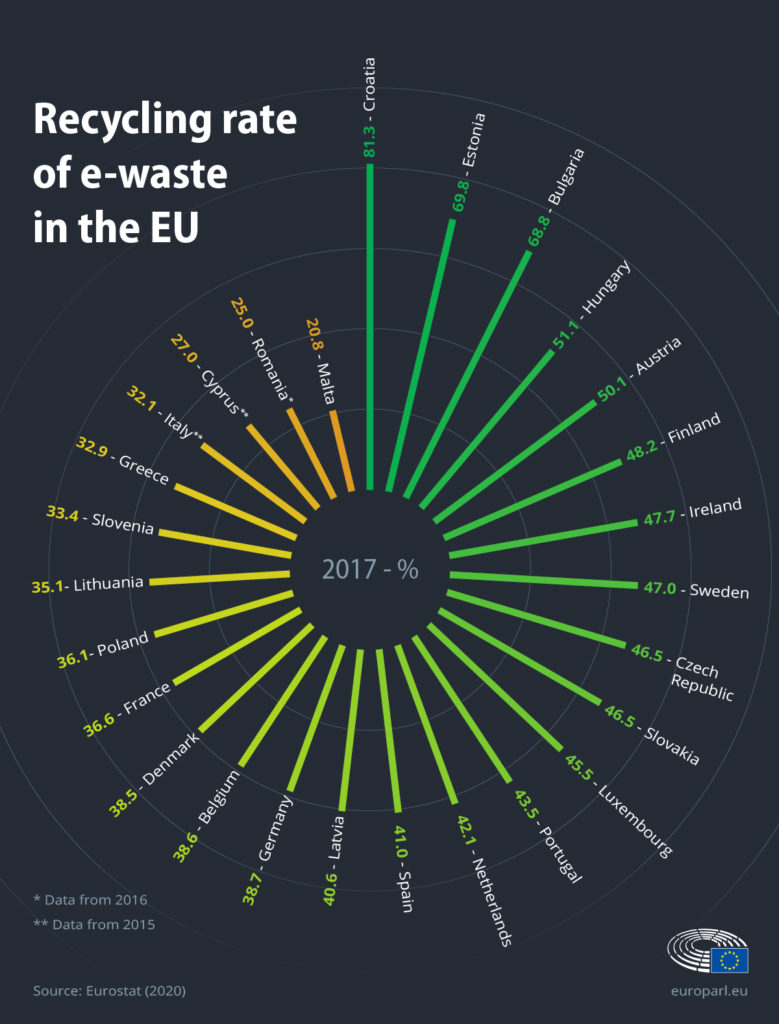Don’t throw it all away
Rapid advances in technology, lower prices for new gadgets and throwaway culture are all fueling our rising levels of electronic waste, known as e-waste. Companies are making sure people keep buying their latest products. Things aren’t designed to last. It is often cheaper and easier to buy new than to repair.
According to Eurostat, e-waste is the fastest growing waste stream in the EU, and less than 40% is recycled. The waste it generates has become an obstacle to EU efforts to reduce its ecological footprint. Recycling practices vary wildly among EU countries. In 2017, Croatia recycled 81% of all electronic and electrical waste, while in Malta the figure was 21%.
Unrecycled e-waste ends up in landfills in Europe or is shipped to developing nations. Either way, e-waste affects human health, the soil, water and food. It has been proven to contain harmful materials, including lead cadmium, chromium and PCBs.

What is the EU doing do reduce e-waste?
There is at least some good news.
The European Commission unveiled its Circular Economy Action Plan in March 2020, lauded as one of the pillars of the European Green Deal. It doesn’t contain hard legislation at this stage, but it does outline future measures to promote durable products that are easier to repair, reuse, and recycle, and suggests steps to support consumers through this transition.
Meanwhile, the European Parliament has sent an clear message that it expects the European Commission to urgently tackle the mountain of phones, gadgets and laptops that are thrown away each year.
Last year, the European Parliament adopted a report written by our Greens/EFA MEP, David Cormand, calling for more sustainable, reusable and repairable products. It specifically called for mandatory labelling clearly informing consumers about the estimated lifetime and reparability of a product, so that they could make more sustainable choices when buying new electronics. It also proposed measures to put a stop to “premature obsolescence”, where products are designed to break or fail after a set period of time.
Just this month, another report on the New Circular Economy Action Plan was adopted. It included a whole section on combatting e-waste, including the Parliament’s suggestions for ending premature obsolescence, developing recycling and reusage schemes for electronic goods, improving eco-design and ensuring a strong “right to repair” for consumers. The Parliament also called on the Commission to come up with a specialised plan for circular and sustainable digitalisation.
What more needs to be done?
- Introduce a new right to repair for consumers. This includes the availability of spare parts, access to repair instructions and updates for all actors in the repair sector, including repair initiatives, as well as a legal guarantee covering repairs.
- Enable consumers to make sustainable choices. A new digital product passport would ensure transparency in the supply chain, along with eco-labels that tell the truth. As Greens, we will fight for mandatory labeling so that consumers know what they’re buying.
- Impose minimum sustainability requirements, including reparability and longevity for all product groups on the market. Additional costs should not be left with the consumers. This is why direct producer liability should cover the lifespan of the product.
- Propose measures against greenwashing and false environmental claims. We urgently need legislative measures to stop practices that result in planned obsolescence.
- Generate jobs and opportunities for the secondary market in raw materials.
- Develop a skills-based labour market and encourage skills transferability in the context of the circular or green transition.
- Promote a culture of reuse and encourage sustainable consumer choices.
- Aim for zero harmful substances, and make sure this is central to goals of the Circular Economy.
- Implement 2030 EU-targets for a significant reduction in material use.
EU citizens should have the right to repair, upgrade and reuse before buying new. Even as individuals, we can all take small steps towards solving the e-waste problem.
Premature obsolescence has no place in a single market that serves the interests of consumers and preserves the planet. We need a European market that favors products that last. Good for your pockets and for the planet! #GreenOurTech
Drop me an email if you want to know more about our campaign #GreenOurTech:
Narmine Abou Bakari – Digital Rights Campaigner
narmine.aboubakari@ep.europa.eu